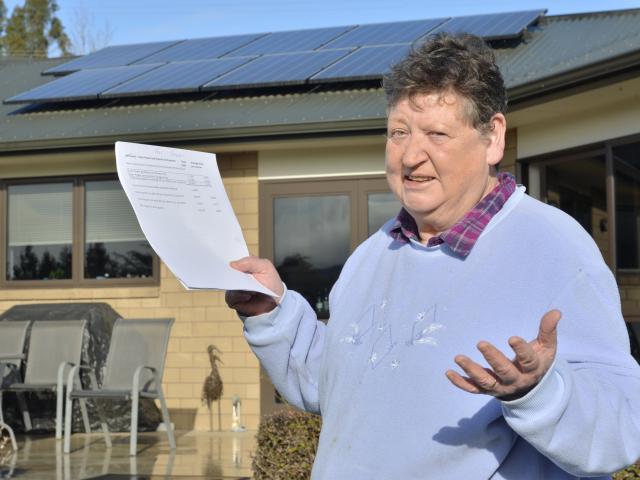
Dot Duthie (69) lives in her house in Palmerston with her 93-year-old mother and a friend.
The "fully-insulated" house in Mull St, built in 2007, has double-glazed windows.
She used gas for some of the cooking and a log burner for most of the heating.
In June 2014, a solar power system, including 23 panels on the roof, was installed for about $21,000.
But since the solar system was installed, the "export price" retailers paid to buy the solar power had dropped to 8c per unit and the price to buy electricity from Meridian had increased to 44c per unit.
"I don’t consider it good business to sell something for 8c and have to buy it for 44c."
The latest power bill, before the prompt payment discount, cost $650.34 for using 1011 units last month.
"This is a significant amount of my superannuation and I thought I was doing everything right."
She was considering ways to "beat the system" including spending more money on solar and "going off grid" or moving to Auckland or Wellington to pay cheaper line charges than she did to OtagoNet.
PowerNet chief executive Jason Franklin said OtagoNet had about 15,000 customers compared to other networks in New Zealand with more than 100,000 customers.
The costs could be spread across the "high density" of customers in large urban networks, unlike OtagoNet with a large rural network with a small customer base.
OtagoNet was the least dense network in the country with three customers per kilometre.
For a residential customer in Palmerston, the line charge would be about 45% of the bill after prompt payment discount, he said.
The "lower user" price plan retailers offered, which Ms Duthie was on, was a concern.
"We have significant concerns about how this plan is operating and the lack of understanding many customers have in relation to the plan."
Electricity retailers are required under Government regulations to offer residential customers a low user price option, of a daily fixed charge of no more than 30c per day, excluding GST.
Customers who install solar panels were often advised by sales people to transfer to the low user tariff.
But these tariffs could be very expensive, as retailers typically charged "very high" variable usage rates.
If the customer used more than the 9000 units per annum from the national grid they were on the wrong tariff and paying too much.
Meridian Energy spokeswoman Polly Atkins said after Meridian was contacted by the Otago Daily Times, it contacted Ms Duthie to suggest ways she could reduce her bill.
The price paid for exported electricity had dropped because Meridian introduced a single flat rate for exported energy in November last year, to bring it more in line with the market.
Authority chief executive Carl Hansen said solar panels typically did not generate electricity during the network peak, which usually occurred after sunset in winter.
Retailers’ ability to offer good export prices depended on when and where the solar energy was exported and how much the wholesale electricity market was prepared to pay for it.
Low electricity prices at the time of exporting solar energy was most likely to be the main driver behind low export prices, he said.
New technologies were expected to allow consumers to store their excess electricity to use at times when they had maximum demand for power, or to export at times when prices in the wholesale market were higher.
The authority had an online tool to assess whether installing solar panels was economically viable for customers, he said.












